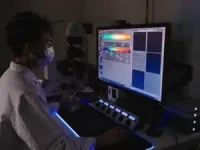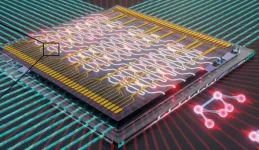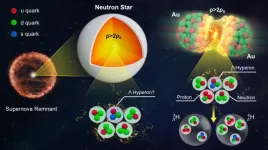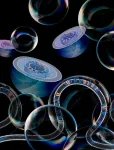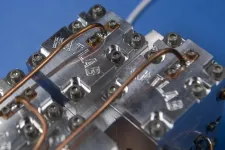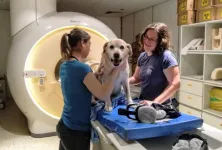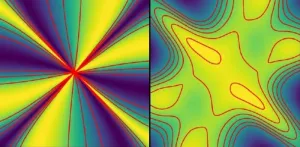(Press-News.org) HERSHEY, Pa. — The first protein-based nano-computing agent that functions as a circuit has been created by Penn State researchers. The milestone puts them one step closer to developing next-generation cell-based therapies to treat diseases like diabetes and cancer.
Traditional synthetic biology approaches for cell-based therapies, such as ones that destroy cancer cells or encourage tissue regeneration after injury, rely on the expression or suppression of proteins that produce a desired action within a cell. This approach can take time (for proteins to be expressed and degrade) and cost cellular energy in the process. A team of Penn State College of Medicine and Huck Institutes of the Life Sciences researchers are taking a different approach.
“We’re engineering proteins that directly produce a desired action,” said Nikolay Dokholyan, G. Thomas Passananti Professor and vice chair for research in the Department of Pharmacology. “Our protein-based devices or nano-computing agents respond directly to stimuli (inputs) and then produce a desired action (outputs).”
In a study published in Science Advances today (May 26) Dokholyan and bioinformatics and genomics doctoral student Jiaxing Chen describe their approach to creating their nano-computing agent. They engineered a target protein by integrating two sensor domains, or areas that respond to stimuli. In this case, the target protein responds to light and a drug called rapamycin by adjusting its orientation, or position in space.
To test their design, the team introduced their engineered protein into live cells in culture. By exposing the cultured cells to the stimuli, they used equipment to measure changes in cellular orientation after cells were exposed to the sensor domains’ stimuli.
Previously, their nano-computing agent required two inputs to produce one output. Now, Chen says there are two possible outputs and the output depends on which order the inputs are received. If rapamycin is detected first, followed by light, the cell will adopt one angle of cell orientation, but if the stimuli are received in a reverse order, then the cell adopts a different orientation angle. Chen says this experimental proof-of-concept opens the door for the development of more complex nano-computing agents.
“Theoretically, the more inputs you embed into a nano-computing agent, the more potential outcomes that could result from different combinations,” Chen said. “Potential inputs could include physical or chemical stimuli and outputs could include changes in cellular behaviors, such as cell direction, migration, modifying gene expression and immune cell cytotoxicity against cancer cells.”
The team plans to further develop their nano-computing agents and experiment with different applications of the technology. Dokholyan, a researcher with Penn State Cancer Institute and Penn State Neuroscience Institute, said their concept could someday form the basis of the next-generation cell-based therapies for various diseases, such as autoimmune diseases, viral infections, diabetes, nerve injury and cancer.
Yashavantha Vishweshwaraiah, Richard Mailman and Erdem Tabdanov of Penn State College of Medicine also contributed to this research. The authors declare no conflicts of interest.
This work was funded by the National Institutes of Health (grant 1R35GM134864) and the Passan Foundation.
END
Protein-based nano-‘computer’ evolves in ability to influence cell behavior
2023-05-26
ELSE PRESS RELEASES FROM THIS DATE:
Gene therapy rescues hearing for the first time in aged mouse models
2023-05-26
By 2050, one in 10 individuals are expected to live with some form of hearing loss. Of the hundreds of millions of cases of hearing loss affecting individuals worldwide, genetic hearing loss is often the most difficult to treat. While hearing aids and cochlear implants offer limited relief, no available treatment can reverse or prevent this group of genetic conditions, prompting scientists to evaluate gene therapies for alternative solutions.
One of the most promising tools used in these therapies—adeno associated virus (AAV) vectors—has galvanized the hearing-loss community in recent years. ...
The mechanisms behind swallowing
2023-05-26
Sensory cells in the vagus nerve can detect and locate food in the esophagus. Their signals help transport the food onward to the stomach. Signal failure leads to swallowing disorders, say a team led by Carmen Birchmeier at the Max Delbrück Center. They have published their findings in “Neuron.”
Swallowing disorders can have many causes, and they occur more frequently in older people. But neurological diseases such as multiple sclerosis and Parkinson’s disease, and certain medications, can also prevent food moving normally from mouth to stomach. Possible consequences include malnutrition, weight loss, and dehydration.
Now a team led ...
Life through rose-coloured glasses
2023-05-26
Over thousands of years some animals have specialised to live in environments where the sun never shines: giant squid with eyes the size of volleyballs see even in the darkest depths while others, like cave-dwelling olms, have lost the functionality of their eyes completely. But for animals that do not live in these extremes, how do species manage a world that suddenly becomes dark? Lakes that become turbid from algal blooms, agricultural run-off, or other environmental pollutants represent common examples of environmental disturbances that can impact the visual scene that ...
Promising building blocks for photonic quantum simulators
2023-05-26
Researchers at the Niels Bohr Institute have, collaborating with the University of Münster and Ruhr-Universität Bochum, developed new technology capable of processing the enormous amounts of information quantum systems generate. Deterministic single photon light sources, creating quantum bits at extreme rates and speed are now coupled to specially designed, integrated photonic circuits, capable of processing quantum information with adequate speed and quality without degrading the susceptible quantum states. This means that the first steps have been taken towards the development of photonic quantum devices that can, for example, ...
First measurements of hypernuclei flow at RHIC
2023-05-26
UPTON, NY—Physicists studying particle collisions at the Relativistic Heavy Ion Collider (RHIC) have published the first observation of directed flow of hypernuclei. These short-lived, rare nuclei contain at least one “hyperon” in addition to ordinary protons and neutrons. Hyperons contain at least one “strange” quark in place of one of the up or down quarks that make up ordinary nucleons (the collective name for protons and neutrons). Such strange matter is thought to be abundant in the hearts of neutron stars, which are among the densest, most exotic objects in the universe. While blasting off to neutron stars to study ...
When the cell digests itself: How inherited neurodegenerative diseases develop
2023-05-26
FRANKFURT. A tangle of pockets, tubes and sac-like membrane structures runs through the cells of humans, animals, plants and fungi: the endoplasmic reticulum, or ER for short. In the ER, proteins are manufactured, folded into their three-dimensional structure and modified, lipids and hormones are produced and calcium concentrations in the cell are controlled. In addition, the ER forms the basis for the cellular transport system, feeds misfolded proteins to intracellular disposal and renders toxins that have entered the cell harmless.
In ...
Army funds two quantum-related projects at Pitt
2023-05-26
The U.S. Army has awarded more than $5.7 million for two projects led by Michael Hatridge, associate professor of physics and astronomy in the Kenneth P. Dietrich School of Arts and Sciences. Both projects bring together a diverse group of researchers to overcome roadblocks in the field of quantum computing.
A four-year, $2.67 million grant is aimed at the next generation of modular quantum computing systems. Hatridge and co-principal investigators Robert Schoelkopf of Yale University have each developed unique ...
Emergence of solvated dielectrons observed for the first time
2023-05-26
Solvated dielectrons are the subject of many hypotheses among scientists, but have never been directly observed. They are described as a pair of electrons that is dissolved in liquids such as water or liquid ammonia. To make space for the electrons a cavity forms in the liquid, which the two electrons occupy. An international research team around Dr. Sebastian Hartweg, initially at Synchrotron SOLEIL (France), now at the Institute of Physics at the University of Freiburg and Prof. Dr. Ruth Signorell from ETH Zurich, including scientists ...
Networks in the dog brain
2023-05-26
A study on canine brain networks reveals that during mammalian brain evolution, the role of the cingulate cortex, a bilateral structure located deep in the cerebral cortex, was partly taken over by the lateral frontal lobes, which control problem-solving, task-switching, and goal-directed behavior. The study relies on a new canine resting state fMRI brain atlas, which can aid in the analysis of diseases characterized by dysfunctional integration and communication among brain areas.
Researchers interested in how dogs think can not only deduce it from their behavior, but they can also investigate their brain activity using fMRI (functional ...
Fractons as information storage: Not yet quite tangible, but close
2023-05-26
Excitations in solids can also be represented mathematically as quasiparticles; for example, lattice vibrations that increase with temperature can be well described as phonons. Mathematically, also quasiparticles can be described that have never been observed in a material before. If such "theoretical" quasiparticles have interesting talents, then it is worth taking a closer look. Take fractons, for example.
Perfect storage of information
Fractons are fractions of spin excitations and are not allowed to possess kinetic energy. As a consequence, they are completely stationary and immobile. This makes fractons new candidates for perfectly secure information storage. Especially since ...

